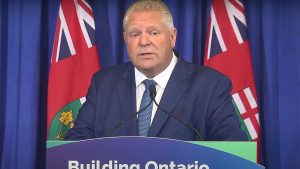TORONTO — Premier Doug Ford’s government has been ordered to keep its hands off three major Toronto bike lanes until a judge can decide whether a plan to remove them is unconstitutional.
The injunction handed down April 22 was heralded as a win by the cyclist group challenging Ontario’s bid to rip up the lanes on Bloor Street, Yonge Street and University Avenue.
“It’s definitely a win for anyone who wants fact-based and data-driven decisions,” said Michael Longfield, Cycle Toronto’s executive director.
“I hope this gives the province an opportunity to maybe pause and reverse this legislation and instead work on real solutions that will keep Torontonians and Ontarians moving.”
A spokesperson for Ontario’s transportation minister said the government intends to respect the court’s decision.
Design work will continue so the government can start removing the bike lanes “as soon as possible should the decision uphold the legislation,” wrote spokesperson Dakota Brasier.
Ford’s Progressive Conservative government gave itself the power last year to remove 19 kilometres of protected bike lanes, over the objections of the city. It passed a law that also requires cities to seek provincial approval to install new lanes that cut into vehicle traffic.
The province suggested that targeting bike lanes on the three major roadways would help reduce Toronto’s traffic congestion.
Ontario Superior Court Justice Paul Schabas, who heard a challenge of the law brought by Cycle Toronto and two cyclists, appeared to be skeptical of that justification.
“There is evidence that their removal will have little or no impact on the professed objectives of the legislation as stated by the minister of transportation,” Schabas wrote in the injunction ruling.
The ruling said despite the government’s claim that there was an urgent need to cut congestion, it presented no evidence about the process to remove the lanes or plans on what would go in their place.
Not granting the pause would mean the government could try to dismantle the bike lanes before he has time to decide the case, Schabas wrote.
“It is likely that the bike lanes are more easily removed than rebuilt or restored,” his ruling said.
Those challenging the law argue that it violates the Canadian Charter of Rights and Freedoms and that removing bike lanes puts lives at risk.
The injunction ruling said the legal challenge raised “important and complex constitutional issues” and Schabas had not yet formed a “final view on the matter.”
But the evidence before him after last week’s hearing, he wrote, is that removing the bike lanes could cause increased collisions, injuries and even deaths of cyclists.
Ford’s recent re-election campaign included fresh promises to reduce traffic congestion in Toronto. He has cited the Bloor Street bike lane, not far from his own home, as part of what’s contributing to gridlock.
Lawyers for the cyclists used the government’s own internal documents to poke holes in that argument last week. They presented internal ministry documents that stated the government’s plan may not reduce congestion.
An engineering report commissioned by the government found any congestion benefits would be negligible or short-lived, a lawyer for the cyclists pointed out in court. The same report found bike lanes were predicted to reduce crashes among all road users by between 35 and 50 per cent.
Schabas’s ruling said the government “relied on anecdotal evidence and the opinion of a real estate management professor who does not appear to directly address the key issue of whether removal of the bike lanes will in fact alleviate congestion.”
The judge’s ruling said the government’s own internal advice suggested accident and injuries were likely to increase if the lanes were removed.
©2025 The Canadian Press










Recent Comments